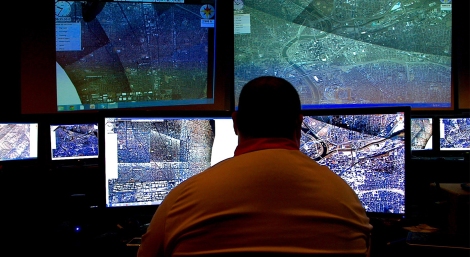
Directed by: Craig Atkinson
Produced by: Craig Atkinson, Laura Hartrick
Executive Produced by: David Menschel
Cinematography by: Craig Atkinson
Music by: Grayson Sanders, Michael Stearns
Editing by: Craig Atkinson, Laura Hartrick
Winner, Best Documentary Film – TriBeCa Film Festival 2016
*****
Editor’s Note: Follow our writer Daniel Jacob Kulick as he considers the most important films of 2016.
*****
Another documentary gathering acclaim this awards season is a film directed and produced by Craig Atkinson called Do Not Resist. This surgical dissection of the militarization of police forces across America focuses on the results of the spillover of the military industrial complex into local law enforcement. Encapsulated within this Cinema Eye Honors nominee for Outstanding Achievement in a Debut Feature Film is the widespread fear that public citizens have of their officers – “sworn to protect and serve” – and the fear those officers have of their communities.
Over the course of the doc, Atkinson (working here as cinematographer across eleven states as well) and co-editor/producer Laura Hartrick take us from Ferguson, Missouri to Richland, South Carolina, then to Washington D.C. and finally back to Ferguson. The situation in Ferguson, so significant in this film, truly exemplifies the kind of technology and weaponry that law enforcement has been acquiring over the last decade. As military equipment falls out of rotation or is bought at a surplus from manufacturers, the Department of Defense and Department of Homeland Security will repackage those assets and sell them to local police. One of the primary examples is an armored personnel carrier called a Mine-Resistant Ambush Protected vehicle (MRAP), featured in the Ferguson police response and more recently at Standing Rock, North Dakota.
Voiceover narration is performed by many of the subjects being interviewed with little overlay text, giving the impression that the characters are admitting self-guilt in their complacency and even encouragement for these purchases to continue. And the large majority of the dialogue comes from members of law enforcement or people involved in the weapons industry. The Special Weapons and Tactics (SWAT) teams also become a critical point of interest to the filmmakers, as we trace their journey from presentations by Lt. Colonel David Grossman (the “killing” expert and a major source of required reading for some police departments and the Federal Bureau of Investigation) to their inter-departmental competitions in Orlando, FL and Richland County, SC. The filmmakers even go so far as to claim that SWAT, once a tool used only in special circumstances deemed too threatening for normal police responses, are now over-utilized in a variety of regular police duties, including a search for illegal drugs featured here.

In the case of the warrant, very little marijuana is found within the suspect’s personal belongings; yet a SWAT team in full armor and gear rolls up to the suspect’s family home and breaks a window in a diversionary tactic before entering the home under supposed fear of retaliation. After an extensive search of the property, the suspect is arrested and willingly turns over cash to be used for the purchase of gardening equipment on behalf of his boss. Instead of turning over these funds to the boss as requested, the SWAT team seizes it as drug money. Despite the very real concerns of law enforcement to have the tools necessary to combat the War on Terror and radical groups/individuals operating within the U.S., Atkinson and Hartrick imply that much more of the focus has been put on continuing the “War on Drugs.”
After the events of the Ferguson riots, our national conversation seemed to shift to the militarization of police forces across the United States. What drives the film’s middle section is the realization that new tools, such as police cameras and tracking of military equipment that has been turned over to the police, are necessary to gain oversight of law enforcement. In reference to some of the newer technologies heading into the law enforcement sphere is a presentation of private surveillance drone companies flying over cities to track the movements of every vehicle and person under their scopes. The filmmakers give the example of Ross McNutt, President and Owner of Persistent Surveillance Systems, who sells his services to police who can then mark and track the daily comings-and-goings of individuals from the overhead camera.

Enter Richard Berk, professor of criminality and statistics at the University of Pennsylvania. Berk discusses a program which will predict the capacity of an individual to commit crime on a sliding scale of very unlikely to inevitable based on a variety of factors, including race; this is similar to an idea featured in Minority Report, directed by Steven Spielberg and starring Tom Cruise. Berk describes his job as a sorting-out of who is Luke Skywalker (essentially good) and who will become Darth Vader (ultimate evil). But while he admits that his algorithm is more likely to determine a small or large likelihood to commit a crime than not, he also openly contradicts himself in allowing that certain individuals may be exceptions to the results of his software.
One thing the film leaves the viewer with is certainty that the culture of America since the attacks of September 11, 2001 has metamorphosed entirely, and local law enforcement has changed with it to become less interested in protecting the public than it in protecting itself. Overall, this documentary confirms many of the unfortunate fears surrounding the militarization of our police forces around the country, while leaving viewers with little to no hope for referenda or changes to the status quo.

